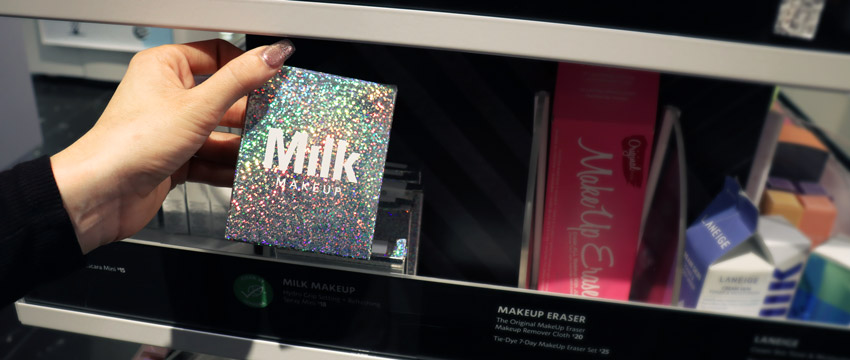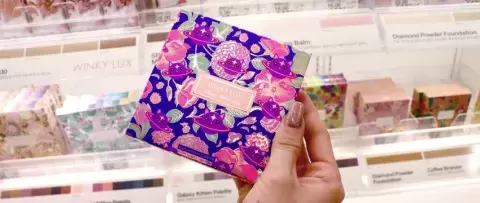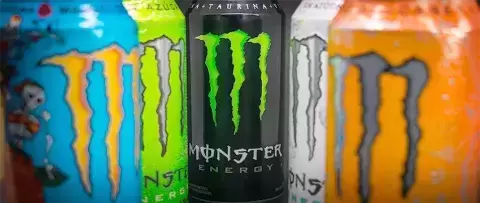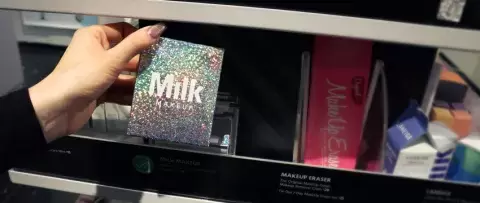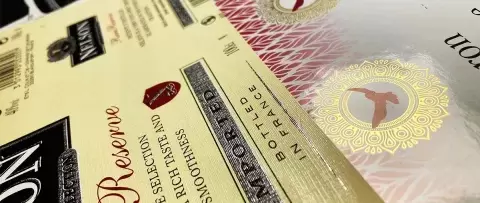Benefits of Special Effect and Functional Inks
How specialty and functional inks can address product and packaging drivers of brand owners
Overview of four product and packaging drivers of brand owners and the specialty and functional inks and coatings that can help them address those drivers. The visual appeal of special effects inks and the functional role of inks and coatings can help brand managers achieve the competitive differentiation and increased market share they desire.
Driver #1: Visual Appeal
The popular saying, “A picture is worth 1000 words,” has been used for years to remind us that strong visuals are more memorable than verbal communication. Visual information is processed by the human brain in a tenth of a second—60,000 times faster than text is processed1. Considered a component of the marketing plan, packaging can enhance a brand and help sell products. As the third largest producer of inks, INX International often gets requests that relate to the visual appeal of a package and/or product.
There are all kinds of products that look the same and blend together on retail store shelves. They may use the same color palettes or visuals. They may use similar package structures. There are studies which have identified the functions of individual packaging design elements such as color, image, shape, material, label and typography, and the perception of the consumer2. Brand owners want to create a sensory experience for their customers that will help them stand out on the shelves, in the stores, and online. They are seeking a striking and immediate first impression. Packaging that appeals to our other senses, such as smell, sound, and touch can also contribute to the overall look and feel the brand owner desires and stimulate additional consumer interest and purchases. Below are some of the unique effects that can be obtained from specialty inks and coatings:
- Tactile: Inks and textured coatings can add a tactile effect to packaging. Whether seeking a smooth and soft touch or a rough and gritty feeling, adding texture to packaging brings dimension to the package and further enhances the consumer experience. INX's Soft Touch coating greets a consumer’s hand with a silky, velvety, feel-good sensation.
- Glow-in-the-dark: Using glow-in-the-dark (GID) ink can be an attention-grabbing effect year-round, but it is especially powerful during Halloween and Christmas when brands want to create a novel and interactive effect. Energy drinks and confectionary products have been early adopters of this innovative ink. We offer GID ink that when charged with indoor or outdoor lighting, it glows when taken into a dark environment.
- Metallics: It is possible to create an array of metallic colors—from silver to gold and all the colors in between—some high gloss and others low gloss. Our high-performance ink is exceedingly suitable for printing on aluminum foil and is often used in food wrappers, pharmaceutical packaging, and more. INX MEUV UV digital inks for flat-sheet metal decorating are optimized for high pigment density and wide color gamut. And, our CPUV UV digital formulations have been fine-tuned for both decorative and functional printing onto metals and epoxy coatings found on beverage containers. (It’s important to note that printing metallic inks and printing on metal are two different things. However, printing on metal and metallic substrates can allow for a metallic effect using a transparent ink.)
- Pearlescent and/or Shimmering: UV inks can create shimmering hues, reflective light, and a pearlescent look and feel. These inks are often used to send the message that a product is high-end or luxurious. Other applications, such as cold foil adhesives, also contribute to that impression. For more information on Cold Foil Applications read our blog post: Three Advantages of Cold Foil Applications.
- Color-Changing, Thermochromic: Inks that are activated by temperature, ultra-violet light, and/or sunlight can change color – either temporarily or permanently. Thermochromic inks can be used to indicate whether a product has changed temperature. Our thermochromic inks all work the same way: below the activation temperature they are colored and above the activation temperature they are clear or lightly colored. As the ink cools, the original color returns.
- Bold Color: The rise in e-commerce has forced brands to rethink their package design to connect with consumers outside the traditional retail environment. Using single, solid, bold, and sometimes unconventional shades and colors is probably one of the most simple but effective trends in e-commerce packaging right now3.
- Natural and/or Organic: There are times when a brand owner wants their product and packaging to have a natural and organic appeal. Using softer, more natural colors (and substrates) can help brand owners appeal to the environmentally conscious consumer.
Driver #2: Circular Economy & Sustainability-Related Drivers
Supporting the circular economy is crucial to driving packaging sustainability, and sustainable packaging has emerged as a top priority for both brand owners and consumers as they show more interest in their environmental footprint. According to Trivium Packaging’s 2021 Global Buying Green Report (PDF), based on a survey conducted by Boston Consulting Group with 15,000 consumers in Europe, North America, and South America, two-thirds (67 percent) of consumers consider it important that the products they buy are in recyclable packaging. The Consumer Brands Association analyzed 50 of the industry’s biggest players to see how they are planning for a cleaner future. Every company listed had commitments to increasing recyclability, minimizing packaging, and/or reusing4. To learn more circular, safe and sustainable inks read our blog post: Supporting a Circular Economy with Safe, Sustainable Inks and Coatings.
A key factor in creating a sustainable package is ensuring that the inks and coatings used on the package do not inhibit the recycling; and when possible, enable light-weighting, compostability, or biodegradability. Petrochemically derived raw materials in a printing ink can often be replaced with clean, renewable, and sustainable ingredients without sacrificing machine, processing, and end use product performance. Yet another packaging sustainability measurement that is becoming increasingly important is its carbon footprint and reducing the carbon footprint of packaging and ensuring any outstanding emissions are offset. To Learn more about ways inks can reduce carbon emission read our blog post: Using Eco-Friendly Inks to Reduce Carbon Footprint.
Although the inks and coatings may only be a small percentage of the overall package, they should typically be tested together with the package in order to determine the degree to which the package is sustainable. The ink and coating industry has made tremendous progress over the last several years; today, there are a variety of innovative inks and coatings that can be recycled and/or do not impede the recycling process, including:
- Washable inks that are easily removed in the recycling process and provide significant environmental, efficiency, and print benefits. Recognized by the Association of Plastic Recyclers, INX Genesis™ GS washable inks make it easier to recycle plastic films used in packaging.
- High-performance, gel-based ink technologies eliminate the challenge of recycling multiple layers laminated together in plastic packaging. Our GelFlex™ EB (electron beam) flexographic inks offers package light-weighting opportunities with the added advantage of elimination of photoinitiator by-products—all while decreasing emissions compared to standard solvent-based inks.
- Natural-based inks can also make it easier to achieve a brand’s sustainability goals. For example, INXhrc™ natural-based inks replace petro-derived ingredients with clean, renewable, and sustainable ingredients. They are free of allergens, nanomaterials, fluorochemicals, fanal pigments, heavy metals, latex, and PTFE. The resins used in the inks contain between 50 and 90 percent natural content, depending upon the application and intended use. On average, this achieves a 25 to 30 percent lower CO2 footprint when compared to standard aqueous inks5. Elimination of carbon emissions from the environment provides measurable and reportable CO2 savings.
- Low VOC (Volatile Organic Components) Inks are better for air quality and the health of print industry workers; and also reduce regulatory risk. Low-VOC printing with water-, soy-, or vegetable-based inks is a good way to reduce VOCs. Most ink producers are replacing petroleum oils with naturally replenishable oils and use ultraviolet (UV)-curable inks and coatings formulated without VOC solvents.
DOWNLOAD
Dart Container achieves measurable carbon and VOC emissions reductions.
Download Case Study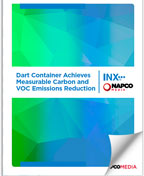
Driver #3: Safety & Product Protection
The focus on clean, contaminate-free packaging and food safety is at an all-time high and will remain a priority for consumers, brand owners, and retailers well into the future. Brand owners are also focused on minimizing risk to the consumer through product traceability, especially food products. Inks and coatings can protect your product and ensure that it is safe and when necessary, allow for increased product and supply chain transparency and/or traceability. Consider the following when selecting inks and coatings:
- Make sure that the inks and coatings being used are formulated to meet (or exceed) applicable industry and compliance standards.
- When packaging food products, use low migration inks and coatings that are specifically designed and tested for use in food packaging applications sensitive to migration issues. When used correctly for their intended application, the migration of ink is minimized. Our low migration and food packaging inks are manufactured in accordance with the requirements of Good Manufacturing Practice. Our food packaging inks are of the highest quality and safe for use as intended when applied.
- Antimicrobial coatings help to reduce the microbes that can cause odors, staining, and natural degradation of the coating which could also compromise the quality of the product. INX has partnered with BioCote® to expand our functional coatings platform and create a range of antimicrobial coatings that are more hygienic and protected against the negative effects of bacteria, mold, and viruses.
- Barrier coatings, including oxygen and water vapor, provide a number of benefits, including: excellent oxygen and aroma barrier; the replacement of PVdC and EVOH coatings; and, extended shelf life. They also enable mono-material packaging which enhances the recycling process.
To learn more about Food Safe Packaging Inks read our blog post: Food Safe Packaging & Inks: 5 Tips.
DOWNLOAD
Learn more about low migration inks and coatings for packaging applications.
Download Brochure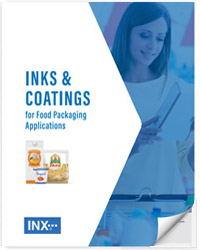
Driver #4: Deter Theft & Counterfeiting (Product Authentication) with Security Inks
Today, it is tough to determine whether we are purchasing a fake product. E-commerce channels, social media, false product reviews, and more have resulted in a rapid increase in the trade of counterfeit products around the world. Brands in all sectors struggle to make sure their brand reputation isn’t compromised by scammers selling fake versions of their products. In fact, the trade of fake merchandise has slowly risen over the last few years and now accounts for 3.3% of global trade, according to a recent report by the Organization for Economic Cooperation and Development (OECD)6. The World Customs Organization reports that counterfeit goods bring in over $650 billion every year7.
There is no doubt that counterfeit products are bad for business and brands. Since many consumers are unaware that the product they purchased is counterfeit, when the item fails to work correctly, falls apart, or just plain doesn’t meet their expectations, the customer will blame the bona fide company. This results in the customer losing trust in the brand and also likely means that they won’t purchase from the retailer in the future.
Thankfully, there are specialty and functional inks and coatings that can be applied to products and/or packages to ensure their authenticity and deter counterfeiting. For example, since 2019, we have been working with product authentication and customer engagement experts, VerifyMe, Inc. and a major beverage brand owner who was experiencing counterfeit and brand protection issues. INX developed the ink used on the beverage cap and incorporated VerifyMe’s marking technology and the beverage cap was successfully tested for protection against counterfeiting. This ink and technology can be used by many different industries experiencing rampant counterfeiting and fraudulent products, including: aluminum beverage cans and bottles, packaging for cannabis, personal protective equipment (PPE), medical equipment, automotive parts, silicon chips, and more. To learn more about brand protection packaging read our blog post: Protecting Your Packaging and Your Brand with Security Inks.
VIDEO
Security inks minimize risk, shield brand reputation, and ensure consumer protection.
Watch Webinar
Conclusion
Product packaging matters and specialty and functional inks make a difference. Their role is crucial to protect the product, attract consumers, and encourage purchases. From in-store purchases to at-home deliveries, consumers value the functional benefits of packaging that keep products safe, secure, and easy to use. Whether a brand is looking to position itself as environmentally friendly, launch a new product, eliminate counterfeiting, or focus solely on premium, luxury products, specialty inks and coatings have become a not-so-secret weapon of brand managers.
According to a survey by global packaging company WestRock, aesthetics are the primary driver impacting consumers’ decisions to try something new, buy something again, or switch brands:
- 81 percent of consumers have tried something new because the packaging caught their eye
- 63 percent have purchased a product again because of the appearance or aesthetics of the packaging
- 52 percent changed brands because of new packaging8
At INX, our specialty and functional inks and coatings help brand managers and packaging converters deliver eye-catching, brand differentiating, special effects that appeal to the senses and enhance shelf appeal. To learn more about our specialty inks and coatings, email INX to request our Special Effects Brochure.
1The Power of Packaging Visuals
2Packaging Design Elements and Users Perception: A Context in Fashion Branding and Communication
35 Emerging Trends in E-commerce Package Design
450 Top CPG Company Sustainability Commitments
5Based on EuPIA dry ink baseline for aqueous-based inks 3.029kg CO2/kg dr
6The Counterfeit Problem And How Retailers Can Fight Back in 2020
7Innovations in Anti-Counterfeit Packaging




